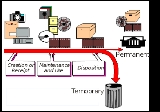
Records Life Cycle
Encyclopedia

Records management
Records management, or RM, is the practice of maintaining the records of an organization from the time they are created up to their eventual disposal...
refers to the following stages of a records "life span": from its creation to its preservation (in an archives) or disposal.
Overview of records life cycle
The records management phase of the records life-cycle consists of:- Creation or receipt of information in the form of records,
- Classification of the records or their information in some logical system,
- Maintenance and use of the records, and
- Disposition through destruction or transfer to an archives.
This is then followed by a second, archival phase consisting of
- Selection/acquisition of the records by an archives,
- Description of the records in inventories, finding aids, and the like,
- Preservation of the records or, perhaps, the information in the records, and
- Reference and use of the information by researchers and scholars.
Continuum model
Richard Berner of the University of Washington proposed a single records management-archives goal: "responsible records use and administration leading to either authorized destruction or archival preservation and administration."The professions of records management and archives, while distinct, surely are working towards the same objective: the effective management of recorded information through all stages of the continuum, from creation to disposal. Effective management of recorded information (what Berner calls "responsible records use and administration") requires ongoing cooperative interaction between the records manager and the archivist in order to:
- ensure the creation of the right records, containing the right information, in the right format;
- organize the records and analyze their content and significance to facilitate their availability;
- make them available promptly to those (administrators and researchers alike) who have a right and a requirement to see them;
- systematically dispose of records that are no longer required; and
- protect and preserve the information for as long as it may be needed (if necessary, forever).

